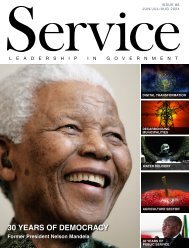Blue Chip Issue 89
Blue Chip Journal – The official publication of FPI. Blue Chip is a quarterly journal for the financial planning industry and is the official publication of the Financial Planning Institute of Southern Africa NPC (FPI), effective from the January 2020 edition. Blue Chip publishes contributions from FPI and other leading industry figures, covering all aspects of the financial planning industry.
Blue Chip Journal – The official publication of FPI. Blue Chip is a quarterly journal for the financial planning industry and is the official publication of the Financial Planning Institute of Southern Africa NPC (FPI), effective from the January 2020 edition. Blue Chip publishes contributions from FPI and other leading industry figures, covering all aspects of the financial planning industry.
You also want an ePaper? Increase the reach of your titles
YUMPU automatically turns print PDFs into web optimized ePapers that Google loves.
BLUE<br />
CHIP<br />
PRACTICE MANAGEMENT | Technology<br />
The Bermuda Triangle of change<br />
in the future of financial advice<br />
For many years, the financial planning profession has been<br />
striving to be recognised as a true “profession”. In this<br />
pursuit, we find ourselves navigating a complex landscape,<br />
which we can aptly describe as the Bermuda Triangle of<br />
financial planning. This triangle consists of three interconnected<br />
elements reshaping the industry as we know it: automation,<br />
artificial intelligence (AI) in the advice and planning stages and<br />
the fascinating field of behavioural sciences. Let’s take a closer look<br />
at our proverbial Bermuda Triangle.<br />
EMBRACING AUTOMATION<br />
Automation provides financial planners with powerful tools to<br />
enhance their services. Here are some key methods of incorporating<br />
automation into the financial planning process:<br />
1. Client onboarding and reporting. Digital platforms are used<br />
to gather client data, introduce services and ensure compliance.<br />
Automation can be applied to simplify investment reports and<br />
financial documents for clients, saving time and improving efficiency.<br />
2. Data aggregation. In a world where financial data is scattered<br />
across various sources, automation can consolidate this<br />
information, offering a comprehensive financial overview for more<br />
informed decision-making.<br />
3. Portfolio management. Investment platforms equipped with<br />
automatic portfolio rebalancing help maintain portfolios aligned<br />
with client goals. Outsourcing this functionality to a portfolio<br />
manager is crucial for effective management.<br />
4. Online presence. Consistency is key in the digital era.<br />
Automation ensures a steady flow of content on social media<br />
platforms, enhancing an advisor’s online presence.<br />
5. Chatbots. Basic client queries are addressed instantly with the<br />
help of chatbots, saving time and providing quick responses to<br />
common questions.<br />
It is essential to remember that the personal touch in financial<br />
planning remains irreplaceable.Automation should serve as a complement<br />
rather than a substitute for the client-planner relationship.<br />
THE FUTURE<br />
Artificial Intelligence (AI) is a transformative force in financial<br />
planning. Combined with insights from behavioural finance, AI<br />
reshapes the future of the profession. Here’s how:<br />
1. Managing emotions and educating clients. Financial planners<br />
guide clients through emotionally charged financial situations,<br />
ensuring that decisions are not solely driven by emotions.<br />
Educating clients about their behavioural biases can make them<br />
more informed and engaged in the planning process.<br />
2. Addressing biases. By identifying<br />
biases such as loss aversion or<br />
overconfidence, planners tailor advice<br />
to counteract these tendencies,<br />
leading to more rational financial<br />
decisions. AI also helps predict<br />
which clients would have more<br />
emotional reactions to market events<br />
and proactively remind financial<br />
planners to reach out to them at the<br />
appropriate time.<br />
3. Improved communication.<br />
Understanding behavioural biases<br />
helps planners communicate more<br />
effectively, resulting in clearer and<br />
more persuasive advice.<br />
4. Simplified choices. Decision<br />
overload can paralyse clients. AI assists<br />
in limiting options, making choices<br />
clearer and more manageable.<br />
5. Hybrid-advice offering. For<br />
clients with straightforward financial<br />
planning needs, such as planning<br />
for children’s education or a holiday<br />
home, automation takes care of<br />
financial planning and goal tracking,<br />
ensuring efficient solutions.<br />
Incorporating these technological<br />
advancements into financial planning<br />
practices enhances the advisor’s<br />
value-add to clients. However, it’s<br />
crucial to emphasise that the personal<br />
touch remains vital. Technology Tiaan Herselman, Head of Advice,<br />
should complement, not replace, Old Mutual Wealth<br />
the qualities of human intuition and<br />
empathy that financial planners bring to their clients.<br />
Furthermore, the incorporation of behavioural finance<br />
principles enables financial planners to provide more personalised,<br />
psychologically-aware advice. This approach leads to better<br />
outcomes and fosters stronger client relationships. As we navigate<br />
the Bermuda Triangle of change in financial planning, embracing<br />
automation, AI and behavioural sciences is not just a strategic<br />
choice but an essential one. In a world where change is constant,<br />
adaptability is the key to thriving and providing invaluable services<br />
in the evolving landscape of financial planning. <br />
40 www.bluechipdigital.co.za


















